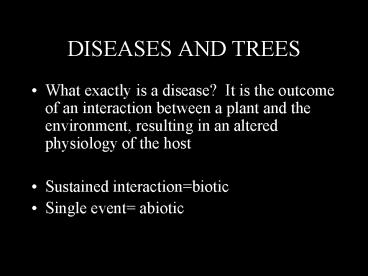DISEASES AND TREES - PowerPoint PPT Presentation
1 / 36
Title:
DISEASES AND TREES
Description:
It is the outcome of an interaction between a plant and the environment, ... Polyphyletic group in evolutionary terms. Basidiomycetes. Ascomycetes. Zygomycets. Animals ... – PowerPoint PPT presentation
Number of Views:74
Avg rating:3.0/5.0
Title: DISEASES AND TREES
1
DISEASES AND TREES
- What exactly is a disease? It is the outcome of
an interaction between a plant and the
environment, resulting in an altered physiology
of the host - Sustained interactionbiotic
- Single event abiotic
2
(No Transcript)
3
(No Transcript)
4
What is a pathogen?
- Strictly speaking a pathogen is the causal agent
of disease - Bacteria
- Viruses
- Nematodes
- Stramenopiles
- Algae
- Phytoplasmas
- Higher plants
5
(No Transcript)
6
(No Transcript)
7
(No Transcript)
8
(No Transcript)
9
And of course fungi
- Fungi saprophytic, symbionts, and pathogens
- Polyphyletic group in evolutionary terms
- Basidiomycetes
- Ascomycetes
- Zygomycets
- Animals
- Plants
- Red algae
- Brown algae
- Myxomycetes
10
(No Transcript)
11
(No Transcript)
12
(No Transcript)
13
(No Transcript)
14
(No Transcript)
15
(No Transcript)
16
(No Transcript)
17
Fungi again!
- Filamentous somatic (vegetative body)
- High surface, good for extrogenous digestion
- Good infection structures, infection peg,
appressoria, rhizomorphs - Chitin in cell wall
- Nuclear ploidy very unique
- Reproduction by spores asexual mode very well
represented - Small nuclei, but with a lot of plasticity
18
(No Transcript)
19
(No Transcript)
20
(No Transcript)
21
Hyphae, sporangia, and zoospores of P. ramorum
22
(No Transcript)
23
(No Transcript)
24
(No Transcript)
25
Fungi do not photosynthesize
- Biotrophic mycorrhyzae, rusts
- Endophites clavicipetaceae,
- Necrotrophic most pathogens
- Saprobes primary (involved in litter
decomposition)
26
Some pathogen roles in natural plant communities
- Selection of individuals best suited for the site
- Maintenance of genetic diversity and stability in
host plant populations - Establishment or maintenance of host geographic
ranges - Natural succession
- Regulation of stand density, structure, and
composition
27
DISEASE!!
- Symptoms vs. signs e.g. chlorosis vs. fruit-body
- The disease triangle
28
host-pathogen-environment
- Susceptibility of individuals or of portions of
individuals - Genetic variability
- Basic compatibility (susceptibility) between host
and pathogen - Ability to withstand physiological alterations
29
Genetic resistance in host
30
host-pathogen-environment
- Basic compatibility with host (virulence)
- Ability to maintain diversity sex vs. no sex
- Size of genetic pool
- Agressiveness (pathogenicity) towards hosts
- Ability to survive without host
31
Chlamydospores of P. ramorum
32
(No Transcript)
33
West Coast
Europe
P. lateralis
34
host-pathogen-environment
- Temperatures
- Shading
- Relative humidity
- Free standing water
- pH and any potentially predisposing factors
- Nutrient status
35
Colony diameter (mm) at 13 days
36
Presence of free water
Between 6 and 12 hours required for infection of
bay leaves































